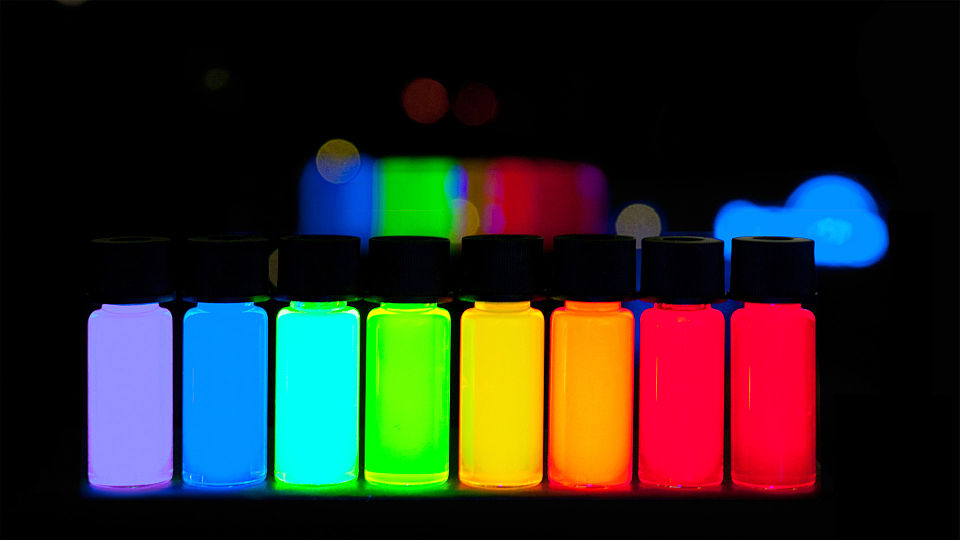
What are quantum dots? Quantum dots are nanocrystals that can be used as semiconductors. You might find them in your TV screen, among many other things. Different size quantum dots produce different colors.
Quantum dots are called quantum dots because they are so small. They are basically nanoparticles. The smallest ones are 2 nanometers across and the larger ones are 6 nanometers across. To put that in perspective, a human hair is roughly 100,000 nanometers across. DNA is about 2.5 nanometers across. Quantum dots are incredibly small. When something gets that small, quantum mechanics starts to take over and classical physics no longer applies. Quantum mechanics governs the movement and behavior of atoms.
When we look at quantum dots we need to look at electrons. All atoms have electrons, but the number of electrons changes depending on the atom. Electrons are elemental particles that have energy and charge and spin. They are not really “things” and they are not really “waves” either. Each electron has a specific amount of energy and orbits the nucleus of the atom in an orbit. That orbit is decided by the amount of energy that the electron has and is a stable orbit. This is called the “ground state” of the electron. Electrons can absorb energy. When they absorb energy, they become excited and they can move to a higher orbit. However, the energy of that higher orbit is also set and the electron needs to absorb exactly the right amount of energy to move up to it. If it is not enough energy or too much energy, the electron won’t absorb it. Electrons that absorb just the right amount of energy and move up to the next energy orbit don’t like to be there. They like to be stable. They want to lose that extra energy as quickly as possible. The release the energy as a light photon, and drop back down to their original stable orbit.
Quantum dots take advantage of this to create colors. Because a quantum dot is so small, the electrons are trapped and confined to specific energy levels. The larger the dot, the lower the energy level. That means the energy of the light photon that the electrons release can be controlled. Small dots release high energy light photons with short wavelengths. We see short wavelengths as blues and greens. Larger dots release lower energy light photons with longer wavelengths, which we see as oranges and reds. That means you can create a series of microscopic dots that produce specific colors.
Quantum dots have a whole host of applications. One that will probably affect most of us is in displays, such as our TVs and our phones. Today, quantum dots can be used along with LEDs in a TV to create brighter, and stronger colors. They are powered by the blue light LED in the back of the TV. However, the next step will be to make TVs that only use quantum dots. They would produce richer colors and they would use far less power because quantum dots are more efficient and don’t lose light. TVs could be three times brighter and many times more efficient. The quantum dots give out light much faster than current TV technology, and their wavelength gaps are narrower, so the quality of the color they produce would be fast, clear, and very sharp. Several technology companies are working on them at the moment, and they will probably be available inside ten years. They would make our phone batteries last longer as well because they would be more efficient.
There are also other uses as well, not just in displays. Quantum dots glow when they are hit by the correct amount of energy, so they could be used to detect for radiation. Different kinds of materials produce different radiation and quantum dots could be painted onto walls where radiation leaks are possible. If the walls are glowing a certain color, people would know that there is a leak. It is a long way off, but they could also be used in the treatment of cancer as well. One of the challenges with radiation therapy for cancer is knowing if the radiation is hitting the right spot. If the cancer was coated with quantum dots, they would glow when the radiation hit them. If there were enough dots, that glow could be visible outside of the body. There are many other uses for quantum dots as well. And this is what I learned today.
Sources
https://en.wikipedia.org/wiki/Quantum_dot
https://www.britishcouncil.org/voices-magazine/what-quantum-dot
https://www.sciencefocus.com/science/are-there-any-quantum-effects-that-we-can-see-in-everyday-life
https://www.wtamu.edu/~cbaird/sq/2014/04/22/why-do-quantum-effects-only-happen-on-the-atomic-scale
https://www.nano.gov/nanotech-101/what/nano-size
https://www.bbc.co.uk/bitesize/guides/zppnn39/revision/2
Image By Antipoff – Photo taken on 28.11.2012, edited in Photoshop last time on 29.06.2013Previously published: http://www.plasmachem.com/shop/en/226-zncdses-alloyed-quantum-dots, CC BY-SA 3.0, https://commons.wikimedia.org/w/index.php?curid=26950552
